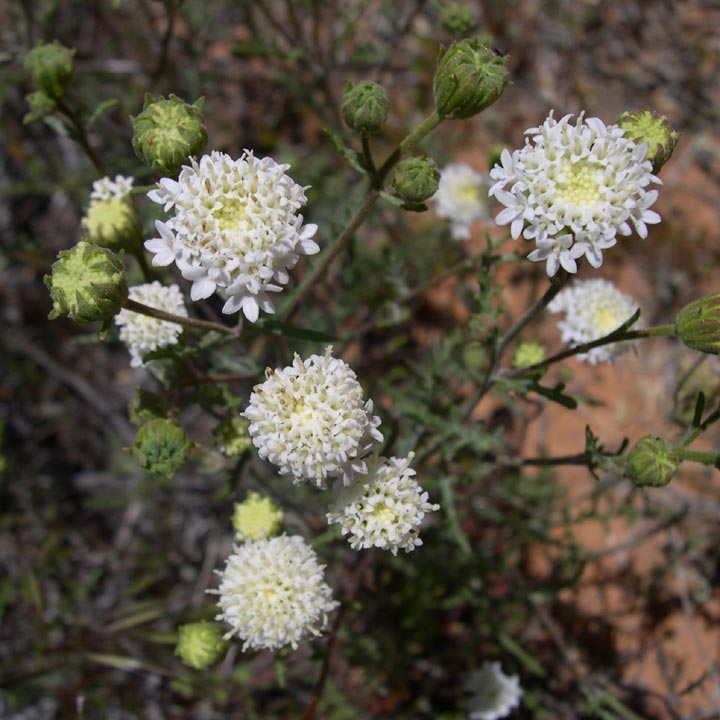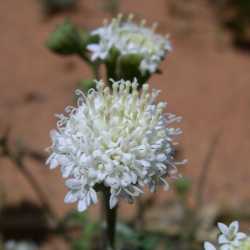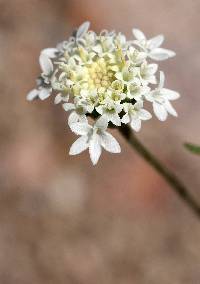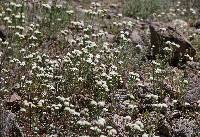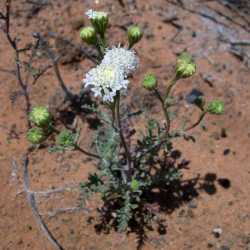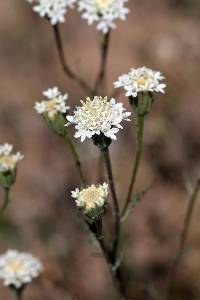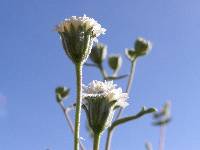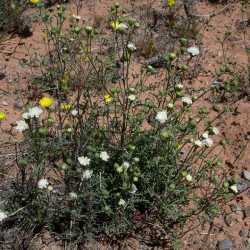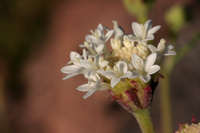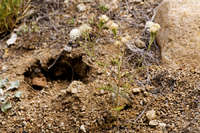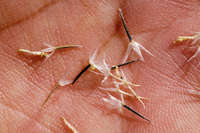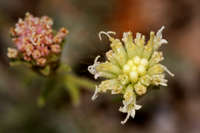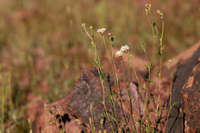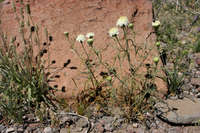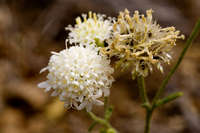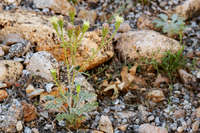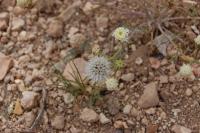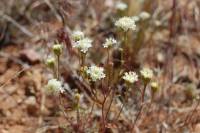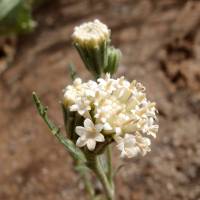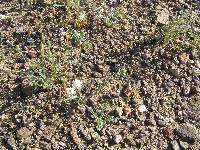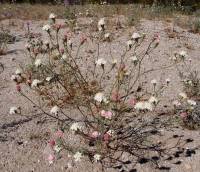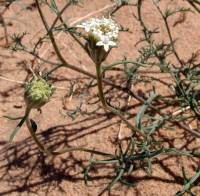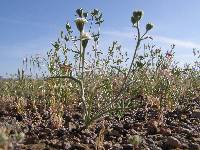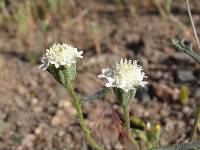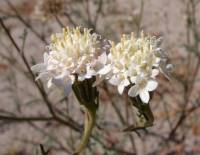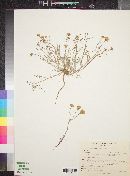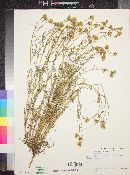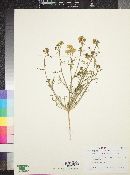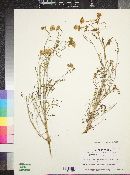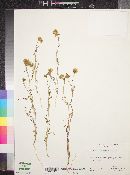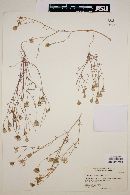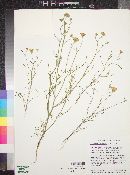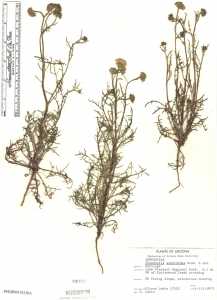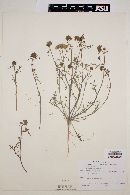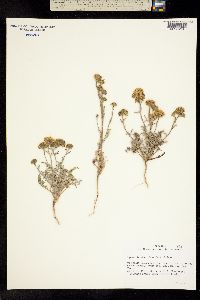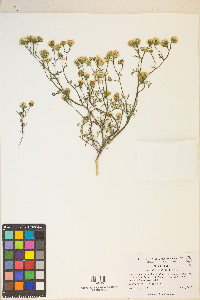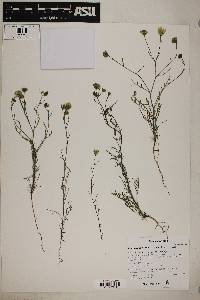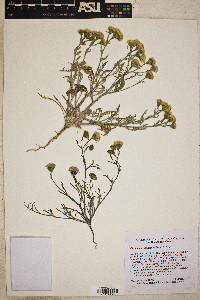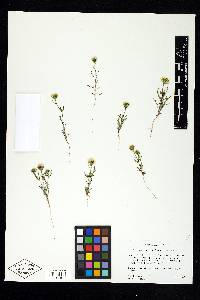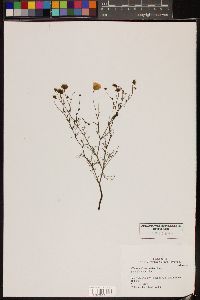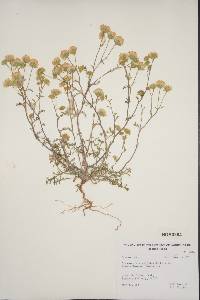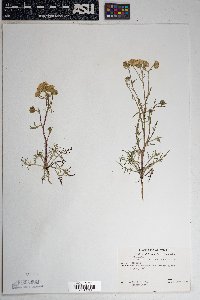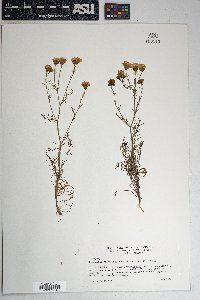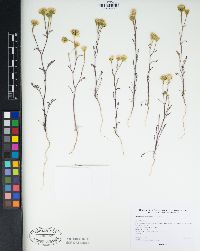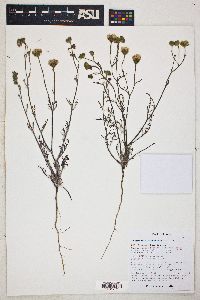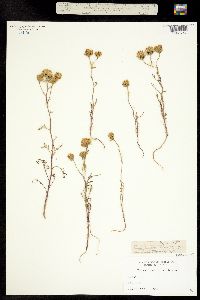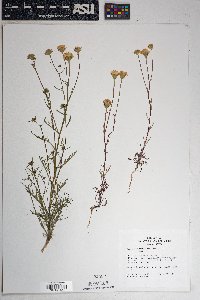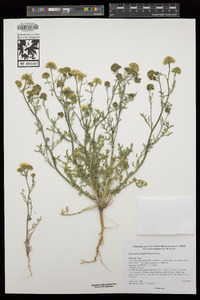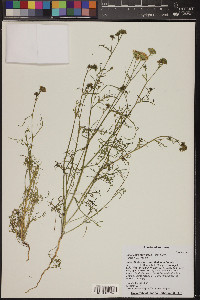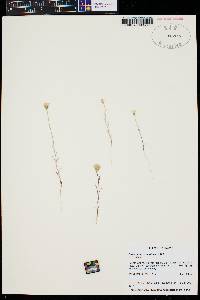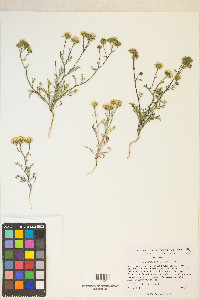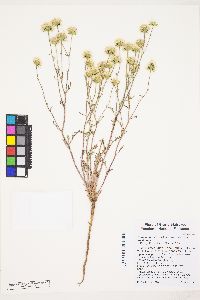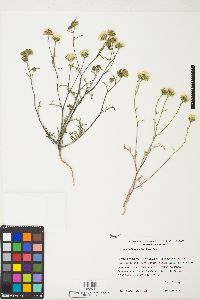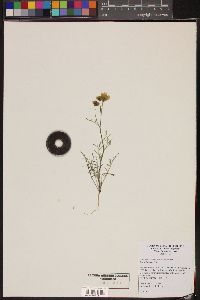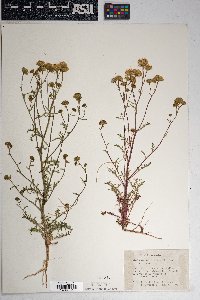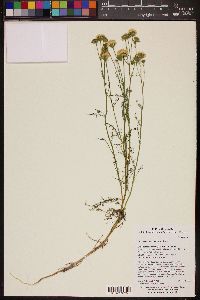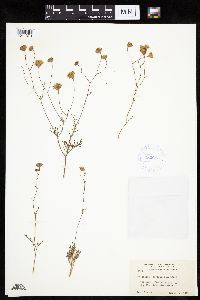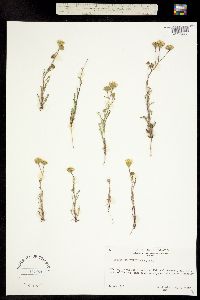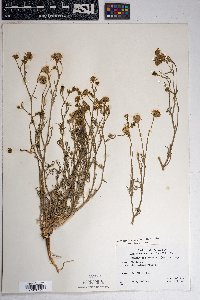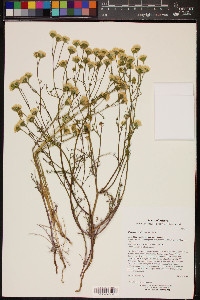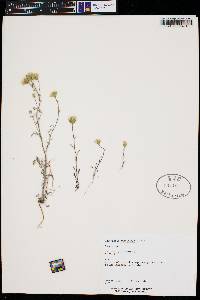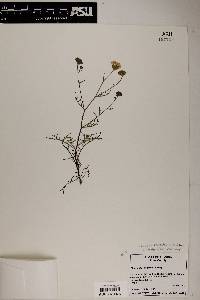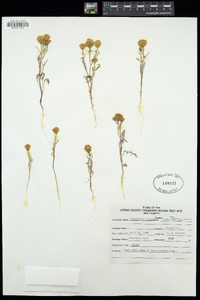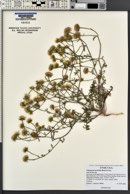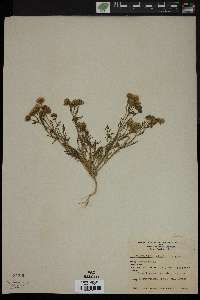Chaenactis stevioides
|
|
|
|
Family: Asteraceae
Broad-Flower Pincushion, more...pincushion flower, Steve's dusty maiden, Steve's dustymaiden, Steve's pincushion
[Chaenactis brachypappa A. Gray, moreChaenactis gillespiei Stockwell, Chaenactis latifolia Stockwell, Chaenactis mexicana Stockwell, Chaenactis stevioides var. brachypappa (A. Gray) Hall, Chaenactis stevioides var. thornberi Stockwell] |
Plants 5-30(-45) cm; proximal indument grayish, ± arachnoid-sericeous (tardily glabrescent except around nodes). Stems 1-12 (sometimes decumbent); branches proximal and/or distal. Leaves basal (usually withering) and ± cauline, 1-8(-10) cm; largest blades ± elliptic, ± 3-dimensional, usually not succulent, mostly 1-2-pinnately lobed; primary lobes 4-8 pairs, remote or ± congested, ultimate lobes ± involute and/or twisted. Heads (± radiant) mostly 3-20+ per stem. Peduncles 1-5(-10) cm, usually stipitate-glandular distally and, often, ± arachnoid. Involucres ± hemispheric to obconic (bases green, rounded in fruit). Phyllaries: longest 5.5-8(-10) mm; outer stipitate-glandular and/or ± arachnoid in fruit, apices erect, blunt, ± rigid. Florets: corollas white to pinkish, cream, or pale yellow, 4.5-6.5 mm (inner); peripheral corollas spreading, zygomorphic, enlarged. Cypselae (3-)4-6.5 mm; pappi of (1-)4(-5) scales, usually in 1 series, rarely with partial outer, abruptly unequal series, longest scales 1.5-6 mm, lengths mostly 0.3-0.9 times corollas (apices hidden among corollas at flowering). 2n = 10. Flowering Feb-Jun. Open, arid or semiarid, sandy or gravelly slopes and flats, shrublands; -30-2100(-2300) m; Ariz., Calif., Colo., Idaho, Nev., N.Mex., Oreg., Utah, Wyo.; Mexico (Baja California, Sonora). Chaenactis stevioides is found throughout the southwestern deserts; it is among the most abundant spring wildflowers in the higher Mojave Desert and southern Great Basin. It also extends seaward into west-central California. It has been reported in New York as a garden escape; it is not expected to persist there outside cultivation. Chaenactis stevioides varies in more or less concentric zones. Plants from the core zone (centered on the Great Basin and Mojave Desert) typically have pappi and phyllaries relatively short and phyllaries predominantly stipitate-glandular (var. brachypappa). Surrounding this zone to the southwest, southeast, and northeast are plants with pappi and phyllaries relatively long and phyllaries evidently or predominantly lanuginose (var. stevioides). Scattered on the periphery in central Arizona, Baja California, and west-central and southwestern California (where hybrids may be involved; see sectional discussion) are mesophytic forms with relatively long and/or broad leaf divisions, corollas varying from white to pale yellow, and pappi and phyllaries like those of var. brachypappa (var. thornberi, C. gillespiei). An unnamed form with leaves arachnoid but otherwise like C. fremontii occurs around sand dunes in the Mojave Desert. Chaenactis furcata and C. latifolia are forms possibly influenced by C. fremontii genes, unusual substrates, or pathogens. Traits of all the above taxa are inconsistent within populations, and/or recurrent or recombinant elsewhere in the range of C. stevioides.
FNA 2006, Martin and Hutchins 1980, Heil et al 2013, Welsh et al 1987, Kearny and Peebles 1979 Duration: Annual Nativity: Native Lifeform: Forb/Herb General: Annual herbs 5-35 cm tall; stems 1-12, freely branching, grayish woolly-tomentulose when young, becoming glabrate. Leaves: Alternate, concentrated on lower stems, the basal leaves early-whithering; blades fleshy but not succulent, 1-8 cm long, pinnatifid or bipinnatifid, the lobes linear, obtuse, with 4-8 pairs of primary lobes, ultimate segments involute or twisted, 2-8 mm long. Flowers: Flower heads discoid, usually 5-20 per stem, arranged in loose panicles on 1-5 cm peduncles, these often stipitate-glandular and/or tomentose; involucre (ring of bracts surrounding the flower head) obconic to hemispheric, 5-7 mm high, the bracts (phyllaries) linear, 5-8 mm, outer phyllaries stipitate-glandular or arachnoid in fruit; florets 8-70, all discs; corollas white to pinkish, cream, or pale yellow, 4-6 mm long; peripheral corollas spreading, zygomorphic, enlarged. Fruits: Achenes 4-7 mm long, brown to black, strigose, with topped with a pappus of 4 scales, these half or more as long as the achene. Ecology: Found on open dry sites, often in sandy to gravelly soils, below 6,500 ft (1981 m); flowers February-June. Distribution: CA, se OR, s ID, NV, UT, AZ, s WY, CO, NM; south to n MEX. Notes: Fairly abundant spring wildflower. Distinctive with its rounded heads and no ray flowers but instead only milky white disc flowers, each of which is topped by 5 somewhat showy corolla lobes; hairy phyllaries; and pinnately lobed basal leaves. Ethnobotany: Used as a heart medicine for children with fevers, and as a glue to bind ceremonial items. Etymology: Chaenactis is from the Greek chaino, to gape and aktis, ray, referring to the enlarged corollas, while stevioides is named for the Spanish botanist Pedro Jaime Esteve (d. 1566). Synonyms: Chaenactis gillespiei, Chaenactis latifolia, Chaenactis mexicana, Chaenactis stevioides var. brachypappa, Chaenactis stevioides var. thornberi Editor: SBuckley 2010, AHazelton 2015 |
|
|
|

